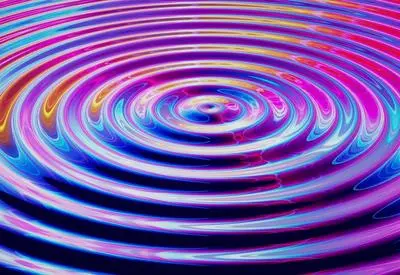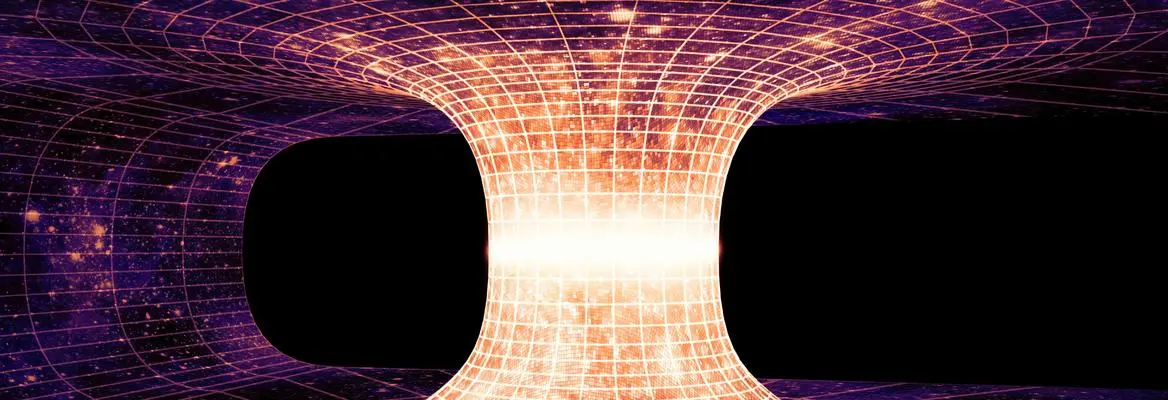Recent headlines about physicists having created a wormhole using Google’s quantum computer are misleading. Not only did they not create a wormhole in spacetime, the kind that Einstein’s equations suggest is possible, they didn’t even create a hologram of a wormhole, as the original Nature article claimed. Martin Bauer explains what the Sycamore experiment was actually all about.
A ‘wormhole’ is a structure connecting disparate points in space based on special solutions of Einstein’s field equations. It’s a feature of the geometry of spacetime often depicted by a folded paper, bringing distant points in direct contact. Dreams of sending information or even overcoming enormous distances in space by travelling through a tunnel in spacetime have fascinated scientists and science fiction writers since wormholes were first described by Einstein and Rosen in 1935. However, we have never observed such a wormhole, nor is it clear whether they even exist in our Universe.
 SUGGESTED READING
Chaos theory eliminates quantum uncertainty
By Tim Palmer
SUGGESTED READING
Chaos theory eliminates quantum uncertainty
By Tim Palmer
Recently reports on a new result seem to suggest otherwise: ‘Physicists Create the Smallest, Crummiest Wormhole You Can Imagine’ writes for example the New York Times. So have physicists created a wormhole by changing the geometry of spacetime? No, they haven’t. The Nature headline on the same result reads “A holographic wormhole traversed in a quantum computer". Holograms are 2 dimensional images that look 3 dimensional, or more generally they capture all the information of a 3-dimensional object. So does this mean physicists created a hologram of a wormhole, showing that the information of an actual spacetime tunnel can be captured on a surface? No, they haven’t done that either.
In order to understand the origin of the confusion we have to look at what was really done in the experiment and how it relates to the concept of a wormhole. Physicists from Caltech, Harvard, MIT and Fermilab ran a program on Google’s quantum computer Sycamore and measured observables in a highly entangled system. Quantum computers are computers in which regular bits, that can take the values 1 or 0, are replaced by quantum bits (qubits) which can hold the values 0 or 1 but also superpositions of these. Because they are quantum mechanical systems, qubits can be entangled. Entanglement is a quantum mechanical effect in which two separate objects have to be described by the same wave function, even if they are spatially separated. Measurements on parts of the system are then correlated with the other part in a way that is unique to quantum mechanics. It is such an important prediction that the experimental verification of quantum entanglement using photons was rewarded the Nobel prize in physics this year. Qubits on quantum computers can be entangled in the same way, and even though the number of stable qubits on quantum computers is currently very limited, they promise to outperform classical computers in the future.
___
This experiment could have been performed without anyone involved even knowing Einstein's equations.
___
All of this sounds like good old quantum mechanics. There isn’t a notion of a wormhole or even gravity in here at all. In fact, this experiment could have been performed without anyone involved even knowing Einstein's equations. So how do we get from here to a wormhole?
The wormhole interpretation goes back to one of the most intriguing results in fundamental physics in the last decades. In 1997, Juan Maldacena conjectured that the equations describing specific quantum systems describe the same physics as the equations of a theory of gravity in a spacetime with large negative curvature. Although this can’t be a theory of our own Universe because our Universe has positive curvature, it was a breakthrough.
Until this point, quantum mechanics and gravity were like oil and water; any attempt of merging the two in a single theoretical framework marred by problems. Suddenly there was a theoretical model where both looked like two sides of the same coin, dual descriptions of the same system: one in terms of gravity and another in terms of quantum mechanics - like two very different languages describing the same object. Since this duality only works if the gravity theory corresponds to a spacetime with one dimension higher than the one in which the quantum mechanical theory is defined, the quantum system can be considered a hologram of the gravity theory.
___
Suddenly there was a theoretical model where quantum mechanics and gravity looked like two sides of the same coin, dual descriptions of the same system.
___
Two different languages require a dictionary to translate, and many physicists working on Maldacena’s conjecture work try to establish what would, for example, a black hole (an object of the gravity language) is be in the quantum language. In principle, one could then perform calculations in the gravity theory, translate the results to the quantum theory using the dictionary and check whether the outcome is consistent. In 2013 Maldacena and Susskind proposed that in this dictionary, quantum entanglement should correspond to a wormhole on the gravity side.


Since a programme on quantum computers can be described as a function of one parameter: time, it can be considered a 1-dimensional quantum mechanical system. So they conjectured that a carefully prepared quantum system with entangled states on a quantum computer can be described by the equations for a wormhole in 2 dimensions. Again, these can’t be dimensions of our own spacetime, but a set of equations that would describe such an object in an abstract 2-dimensional spacetime.
Physicists working on the Sycamore experiment demonstrated that it is possible to perform manipulations on the entangled quantum system so that a message injected in one part of the system can be recovered in another part in a way that can be described as a message traversing a 2-dimensional wormhole in the dual description. It is in this sense that the dynamics of traversing a holographic wormhole were reproduced on a quantum computer. In this case, the program ran on only 9 qubits, which makes the application of the duality more difficult and even questionable because the conjecture assumes arbitrarily many qubits to work. But there is no doubt that this and other experiments inspired by the duality will be performed on more advanced quantum computers in the near future and the authors expect new quantitative insights about the gravity theory if they can repeat the experiment with around 100 qubits.
___
Physicists working on the Sycamore experiment demonstrated that it is possible to perform manipulations on the entangled quantum system so that a message injected in one part of the system can be recovered in another part.
___
One can choose to simply ignore the duality aspect of the experiment and treat it as one more confirmation of quantum mechanics, or one can interpret it as evidence that the duality works as expected. A useful analogy are water circuits which are often used to learn about electric circuits. One can consider water circuits as a confirmation of hydraulic theory, but one can also obtain a better understanding of electricity without ever getting an electric shock. Similarly, the quantum computer programme never risked rupturing spacetime. The conjectured duality goes much further than the hydraulic analogy, and quantum computers can provide valuable insight into the dual theory that might one day help us to understand whether our own, much more complicated Universe, has holographic properties too.

There are many reasons for the confusing messaging around this experimental result. Wormholes are an enormously popular physical concept that immediately triggers the image of spacetime tunnels, whereas the word is used in a more abstract sense by physicists working on the topic. There is a need for science journalists to make science sexy. Often headlines of articles as well as titles of books aren’t even set by the authors but constructed by editors to gather maximal public attention.
 SUGGESTED READING
Reality is just a quantum wave function
By Alyssa Ney
SUGGESTED READING
Reality is just a quantum wave function
By Alyssa Ney
And there is the fact that the authors chose not to share a preprint before publication. Sharing results widely before publication allows other physicists to comment and correct overly dramatic and wrong statements. A process that is good for science and is the established norm accepted by many scientific journals in physics for many decades. It is the responsibility of scientists and journalists to make sure that results like this are communicated in a way that doesn’t mislead the reader, but it’s also the responsibility of the reader to read beyond the headline.



















Join the conversation